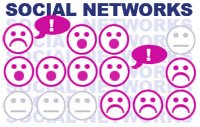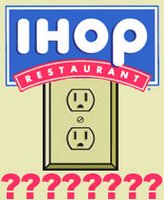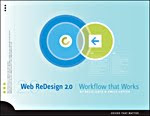Experience & Branding Competency: The Three Word Rule
The clear leaders in Customer Experience typically share one common trait - the "Three Word Rule" applies to them. First, they can easily articulate what they do better than any one else in less than three words. Second, they reflect this core competency in everything they do:
What's your core focus? Can your employees articulate it? Do your customers get it?
- Starbucks brings us coffee and community
- Amazon sets the standard for online retail
- REI delivers recreation and adventure
- Best Buy offers electronics and entertainment
- Great Harvest warms us with local baked goods
- Progressive innovates insurance
- Coca-Cola brings us liquid refreshment
- Disney entertains us with innovative story telling
What's your core focus? Can your employees articulate it? Do your customers get it?
Monitoring Social Networks
 According Fortune Magazine, to figure out what the blogsphere is saying about your brand, you would have to pour through 350,000 daily postings on a staggering 20 million blogs worldwide. Daunting? Yes.
According Fortune Magazine, to figure out what the blogsphere is saying about your brand, you would have to pour through 350,000 daily postings on a staggering 20 million blogs worldwide. Daunting? Yes. Be not afraid - just get out your pocketbook! As companies moblize to monitor social networks and word-of-mouth, they need to prepare to pay for buzz monitoring. There are a number of companies branching in to this arena. Check out this recent recent Fortune article profiles the type of functionality I discussed mentioned in my recent post about social networks and customer service.
The article highlights Umbria Research's technology for scanning the blogosphere for brand-related posts. The technology applies rules, assumptions and logic to categorize and profile brand-related feedback from the blogosphere at an incredibly fast rate. Umbria even claims to be able to approximate blogger profile data, including age/= and sex, in addition to classfiying comments based on tonal qualities, like scarcasm. Businesses can subscribe for Umbria's buzz reporting for roughly $60k, per year, making the service competitive and more affordable than some other competitors (Intelliseek, BuzzMetrics).
Resources: Adrants, via CNN, via Fortune.
Blog, Gripe, Win!
 Social networks seem to be following the model of other mass media channels. The flow is like this:
Social networks seem to be following the model of other mass media channels. The flow is like this: Proliferation--> Networking --> Clustering --> Aggregation.
We're seeing this with web logs today, which continue to proliferate at an astounding rate. Networking is common, as like minded sites swap links, and reference each others' content. We're even seeing some weblogs merging with other "like minded" sites to form larger, destination blogs. We're also seeing services focused on taking the pulse of the blogosphere by topic, brand, etc... and using this information to produce aggregate metrics and reporting. It started first with the the blog companies and Technorati... and continues now with major web analytics and research firms.
No doubt, we'll continue to develop a more sophisticated ability to connect our own worlds with those of others. It's kinda fun to watch it unfold. As social networks relate to customer service, I think we're in for some interesting times.
Here's a fun example: Check out "Every Day Hogwash, a new site dedicated to cataloging horrifying -- yet entertaining and humorous customer service stories. Post a link to your story, and you may just win a daily, weekly or monthly cash prize between $200 - $5,000! It's simple.
Complaining for prizes?! People will love this.
Okay sure, the site is limited. There's no ability to search or filter by topic or company. There's no email confirmation for your submission. It's not clear who is running the site -- or why -- although the panel of judges is impressive and includes one of my heroes of humor and insight, Ze Frank). But hey -- it's a start -- and the world of bloggers will love getting paid for something, for a change. ;-)
What’s next? Imagine the power of an aggregate engine that standardizes and catalogs customer stories, breaking them down into rankings and ratings, satisfaction rates, reports ... like the rating system for Amazon on steroids. Fully searchable by company, topic or type. A valuable tool, a wealth of insight into word-of-mouth banter. Stay tuned for more.
Bad News: Beware the Public Blogging
 When was your last bad experience? I mean, one that either stunk or was memorably dissatisfying? Just out of curiosity, how many people did you tell about your experience? What about the companions who may have been with you?
When was your last bad experience? I mean, one that either stunk or was memorably dissatisfying? Just out of curiosity, how many people did you tell about your experience? What about the companions who may have been with you?Bad news a viral thing. Today, it can travel farther and faster than ever before. Modern technology and sophisticated search algorithms have created social networks without boundaries. These networks connect us with everyone and strengthen word-of-mouth dynamics. They enable us to spread ideas with lightening speed. They enable others to vicariously participate in our experiences as we share them – good and bad.
Social networks aren't new, but the these emerging dynamics make it critical to evaluate their potential impacts on business and brand equity. In this day and age, it’s entirely possible to cross the wrong customer; the one who, with the piercing voice of a town crier, can readily air our "dirty laundry" to the public; leaving us scrambling to explain - or even righting the wrongs we've committed at a humbling pace. Consider the following example from Comcast, as summarized below:
A Comcast customer service employee becomes irked by a customer who is trying to resolve a rather serious problem related to a misdirected check. At some point in the discourse, the representative accesses the customer's file and changes her name in the computer system to "Bitch Dog." The name later shows up on the customer's August billing statement. The upset customer becomes outraged and contacts the media. The story is soon picked in the news and an escalating number web log posts, which (to-date) have reached 293 in number. The story results in a ton of high profile negative exposure for Comcast, the termination of two involved Comcast employees and multiple, public apologies to the customer.
This is just one of a myriad of emerging customer service stories that have corporations quaking in their boots - and well they should. In a recent "2006: State of CRM" presentation, Gartner claims that "always-informed customers will form new communities and will find new ways to protest and to exact revenge." Gartner goes on to predict that social networks, tracking and privacy management will rise to the fore in as key CRM competencies in 2006.
Customers are only going to get more sophisticated in their ability to rate, rank, assess, and talk about the quality of experience being offered by companies today. All the more reason to offer better experience, my dears. Unfortunately, we must be mindful that customers may be more vocal about bad experiences than they are about what's good. Are you ready for the challenge?
Companies that ignore social networks may be surprised in the future by receiving “public bloggings” in the new town squares of the Internet. Proactive, leading companies will rise to the occasion and find ways to better map and manage customer experience in the context of socially networks. They will find ways to positively harness social networks to resolve outstanding customer service issues and build stronger, more competitive brands as a result.
Seize the day.
Plug & Pancakes?
 When I recently saw signs at IHOP boasting wireless access, I was stoked: breakfast, high speed access, decent tables and a bottomless cup coffee. This didn't seem like a bad substitute for a decent internet cafe. Unfortunately, we don't have many of those in Northern VA.
When I recently saw signs at IHOP boasting wireless access, I was stoked: breakfast, high speed access, decent tables and a bottomless cup coffee. This didn't seem like a bad substitute for a decent internet cafe. Unfortunately, we don't have many of those in Northern VA.Last Friday, very hungry after skipping breakfast, "IHOPped" over for a late breakfast and a four hour click and grind.
Laptop at the ready, I attempted to find a seat with an outlet. I quickly discovered, with the help of a hostess, that there were no table accessible power outlets.
Not one outlet anywhere near one of the 47 tables - or 182 seats - in the restaurant. The only ones I could have stretched to use would have forced the wait staff to hurdle my power cord, at risk of life and limb. This was preturbing.
On battery power, I had enough time to work through an eggwhite omelette a switch to decaf before I got the half hour warning on my laptop... I ended up packing up for Starbucks. In the end, they made their two bucks (or whatever their Wayport internet access was) in addition to the price of my breakfast -- but they failed to make me a happy customer.
Driving to Starbucks, I began to ponder the following:
First, I thought business in general, and how important it is to fully plan customer experience before attempting to capitalize on new markets. With regard to the growing mobile workforce, it's necessary to think through logistics like power outlets, table space and comfortable seating. Make customers happy and build the profit model around the experience- not the other way around.
Next, I wondered if the failure to add outlets by IHOP is an intentional move. After all, IHOP makes the bulk of its profit from the quick rotation of breakfast rush patrons. This is true Monday through Friday - and an extended rush occurs on the weekends. Therefore, people who “park” at IHop during these peak hours might be considered a curse.
Finally, I decided that places like IHOP are missing out on good opportunity. Many are located in or near hotels, and most are on major thoroughfares. Why not create a small allocation of space within these places for mobile workers? Many of these restaurants are eradicating smoking areas! Why not convert part of this space into IHOP lounges? Offer us high speed, bottomless coffee, a few trash cans, comfortable chairs and even tables big enough for a few papers! Sure, this may change the model, a bit, but so did play equipment at McDonald's at one point in history. Now, they're everywhere.
Changing times drive experiential change. Planning slightly ahead of the change curve can help businesses capture new markets with simple innovation. By capitalizing accordingly, companies can offer new experiences that drive customer loyalty and foster the repeat business that will drive future successs. Where is your next opportunity?
Update & Feedback
 I'm a bit late on the uptake, sorry! Mark Hurst recently responded to my recent comments in his good experience newsletter. Evidently, Mark's original post triggered a great deal of response and feebdack - scroll to December 12th posting to read. Thanks, Mark. I feel sufficiently heard. :-)
I'm a bit late on the uptake, sorry! Mark Hurst recently responded to my recent comments in his good experience newsletter. Evidently, Mark's original post triggered a great deal of response and feebdack - scroll to December 12th posting to read. Thanks, Mark. I feel sufficiently heard. :-)----------
Also, in response this post, and along with several others, Arturo Munoz offers this feedback:
How can customer experience be anything but subjective? In as much as we try to treat our customers with attentiveness and respect, building an environment of service and appreciation for their patronage, a customer perceives and will experience what the customer alone can experience.Arturo, thanks. You make an excellent point. There will always be a degree of subjectivity related to customer experience. However, this doesn't mean that customer experiences can't be made more manageable, measureable, pleasing and synchronized across channels. This is the core focus of Customer Experience Management.
Our power lies in influence, in how we approach a customer or respond to his inquiries. But how the customer experiences our treatment or response is something that can move in any number of directions outside our control. We must acknowledge the limitations of what serving a customer can accomplish.
Consider McDonald's; a company that, over many decades, has done an incredible job of creating and fine tuning their experience. McDonald's literally invented the business of fast food, in many respects. The experience innovation deployed by "Micky D's" not only works to preserve consistency and reliability of service, it is also keenly focused on driving operating efficiencies, reducing risk, making the jobs of service workers easier and driving a fat bottom line.
When customers go to McDonald's, they know what to expect from the experience. Most can recite items from menu without even looking. They know how to order, where to find the napkins, drinks and condiments... even intuitively where the bathrooms are. Customers know how the food will taste, how it will be served and packaged. They know if a mistake happens (e.g. no cheese on my cheeseburger), that someone will work to make things right.
Even so, McDonald's understands the experience won't hook and reel in the repeat business of every customer. Take me, for example. I am one of those customers who'd just rather steer clear of McDonald's.
McDonald's knows it's not possible to please all the people all of the time. Within its limitations, the corporation works actively to secure repeat business by providing consistently reliable quality and service. They employ innovation to maximize relationships with the most promising and profitable target audiences ... which is why they've invested in children's play areas and now offer some healthier food alternatives...
We can't use subjectivity as an excuse to ignore our responsiblity to architect excellent customer experiences and service our customers with quality and consistency. While we must recognize and work within real limitations - and around the subjectivity of the individual- most of us haven't scratched the surface of our potential in this arena.
Customer Experience Resolutions?
 If you’re anything like me, you’re still coming down after a busy holiday season. This year, my holidays were mixed with a substantial amount of business travel, which is the reason my posts have been lighter lately.
If you’re anything like me, you’re still coming down after a busy holiday season. This year, my holidays were mixed with a substantial amount of business travel, which is the reason my posts have been lighter lately. I’ve been spending a great deal of time discussing Customer Experience Management with a number of clients, from large-scale Health Care and Pharmaceutical organizations to global software companies. As recurrent themes with my clients arise, it occurs to me that perhaps this is a great time for C-level executives to adopt some “Customer Experience Resolutions” for 2006.
Here are five considerations:
1. Deliver the Customer Experience Fundamentals. Product and service innovation can be expensive, and will count for little if the underlying customer experience is lacking. Follow the example of CEM leaders like Nordstrom’s to build consistently solid customer experience. The CEM Fundamentals (see article) are business and channel agnostic principles that can help any organization deliver better customer experience.Now, don't get me wrong - I'm not an idealist, and know these are huge considerations that, as resolutions, may require more than year's worth of effort. Certainly, however, the items above are worthy of the attention and consideration of leadership. Certainly they will require change and a little pain. Even so, I'm firmly convicted that the organizations that don't become more adamantly customer-centric and skilled in delivering consistently solid, satisfying experience will be left behind in the future.
2. Adopt an “outside in” perspective. Too many companies have become so internally focused they no longer have an objective view of how the business, products, services are perceived by customers. When this happens, corporate staff can become mired in executional detail. Competing priorities can result in operational barriers that compromise customer experience and negatively impact business outcomes. A customer-centric perspective can directly support business improvement efforts and prioritize business activities.
3. Create a customer learning environment. Okay – as a CEM fundamental, this overlaps a bit with items 1 and 2 above, but this must be said. According to Gartner, 76% of C-level executives believe customer experience is increasingly important, yet 65% of them admit that their executivesare not frequently spending time with customers!
David Neeleman, CEO of Jet Blue Airlines, understands the importance of customer engagement. He manages to fly his airline once a month to obtain feedback from customers and employees. Neeleman has applied customer learning to create a positive airline experience and build market distinction for Jet Blue.
Spending time with customers - and developing an infrastructure that allows your company to measure and improve customer experience (databases, integrated marketing and service tools) is essential for success. Simply put: Watch, listen, ask, learn and remember.
4. Create an “Experience Agent” Culture. According to Gartner, only 19% of companies have rewards tied to quality of service. Take a tip from the Gore Company (Makers of GoreTex products and Glide Dental Floss), where everyone is considered an “Associate” and product team sizing is meticulously managed to keep small-company collaboration and production at peak. Imagine what would happen in your company if everyone became a customer experience agent – if compensation and performance ratings became more tangibly and meaningfully tied to customer-related goals and objectives. How would it impact quality outcomes? How could this benefit employee morale and focus? What would it do for your customers?
5. Walk the Talk. I've been spending a lot of time with CMO senior marketing and operations executives who think Customer Experience Management is a “marketing thing.” I find myself consistently realigning perceptions as I illustrate CEM as a discipline that involves complex management and coordination of customers, their environments, interfacing dynamics, the supporting platform, goods and services. CEM mandates must therefore be driven and coordinated from the top -- and supported across all areas of the business.
Tom Peters said it well "There is (Perhaps?!) Only One Big Issue: Crappy X-Functional Communications." Today’s C-level executives must find ways to bridge the gaps and facilitate better communication and collaboration between divisions(e.g. marketing, product development, customer service, sales, business development and technology) in order to engineer and deliver customer experiences that are consistently satisfying and differentiating.
...Just some food for thought as we press into a new year.
Photo Courtesy of the Times Square Alliance
Subscribe to:
Posts (Atom)
FAVORITES
- On Trust & Influence
- Don't be Social Media Sharkbait
- The Social Media Engagement Continuum
- 10 Tips for Twitter Unmarketing
- Five Experience Funamentals
- Experience & Branding: The Three Word Rule
- Get Some Experience Healing!
- Discovering Customer Experience Pitfalls
- Not My Job: The CX Enemy
- Shoe Carnival: Watch Out for Carnies!
- Bathroom Usability
RECENT COMMENTS
SEARCH
LEIGH DURST

I’m Leigh Durst, a 20 year veteran in business, operations, customer strategy, ecommerce, digital & social media and marketing. Simply put, I’m a strategist that helps companies (start-up to blue chip) achieve business shift, create more compelling online and offline experiences. I also write, speak and teach about experience design and next-generation business. I’m a futurist, visionary, strategist, doer and connector with a passion for people and helping others. When I’m not on the road, you’ll find me in the San Francisco bay area, working, beaching it and hanging out with my family and dog.
Labels
advertising
air travel
bank experience
bathrooms
Best Practices
branding
brick and mortar retail
charlene li
Community
Content
Copy writing
cottonelle
customer centricity
customer experience
customer experience files
Customer Experience Leaders
customer experience management
customer experience pitfalls
customer experience; innovation;
Customer Relationship Management
customer research
CX
Defining Customer Experience Management
economy
Ethics
experience best practices
experience file
experience pitfalls
good customer experience
Group Think
Harassment
infrastructure
Innovation
life
marketing
marketng
motherhood
old navy
personal
Plagiarism
Plurk
privacy
reinvention
RESOURCES
restaurant experience
retail experience
security
Social Media
Social Media Expert
social networking
starbucks
stuck
target
toilet paper
trust agents
trust continuum
Twitter
usability best practices
user experience
user experience
UX
Web 2.0
Web Strategy
word-of-mouth


